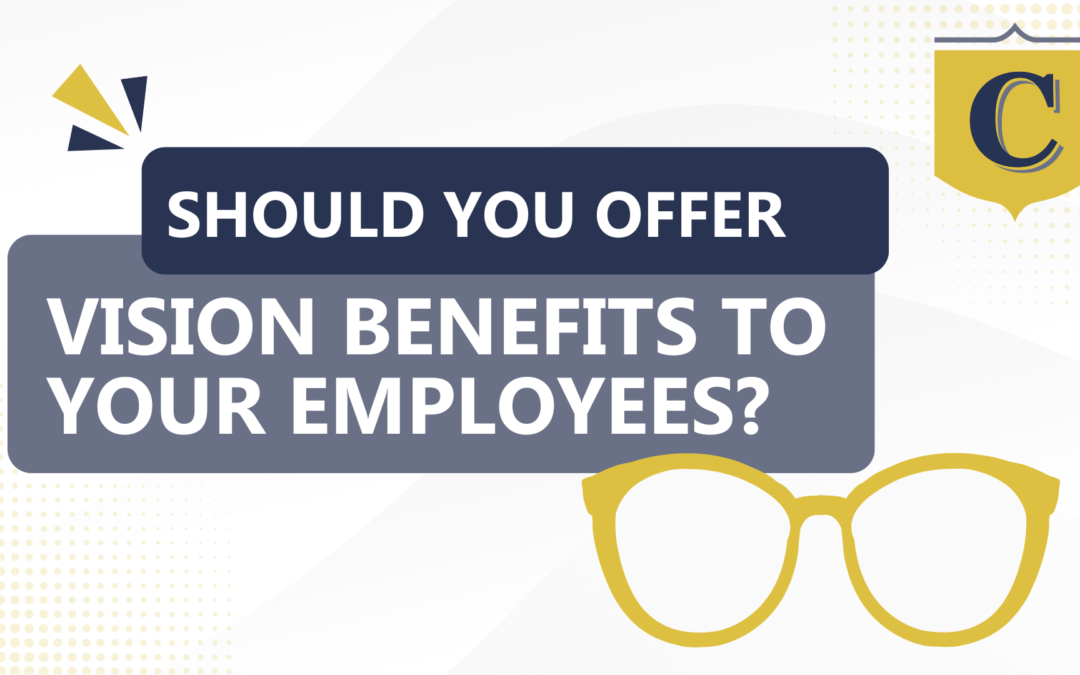According to the Centers for Disease Control and Prevention, approximately 14 million Americans suffer from some sort of visual impairment and 11 million need vision correction. Your medical plan may cover certain eye conditions, like cataracts, glaucoma and cancer, as well as injuries to the eye. It may even cover the cost of an annual eye exam. However, it likely does not offer benefits for prescription eyewear and elective eye treatments such as LASIK and PRK laser eye surgery. Coverage for those services would be available through an employee benefits vision plan.
How vision plans work
Most vision plans are designed to supplement regular health insurance. They help employees by reducing the cost of preventive care and prescription eyewear.
Eye exams and vision screenings are usually covered at little to no cost. Materials like lenses, frames and contact lenses are covered at a certain percentage or dollar amount. In most cases, glasses or contact lenses are covered, but not both.
The employee pays a monthly premium and benefits are provided according to a schedule. For example:
- Eye exams are covered once every 12 months.
- Lenses are covered every 12 to 24 months.
- Frames are covered every 12 to 24 months.
- Contact lenses are covered every 12 to 24 months.
- Lens protection such as scratch-resistant coatings are covered every 12 to 24 months.
Some plans even offer discounts on:
- LASIK corrective eye surgery
- Contact lens fitting fees
- Disposable contact lenses
Choosing a plan for your employees
If you think your employees would benefit from additional access to preventive vision care and discounts on glasses and contact lenses, a vision plan may be right for you. There are a number of national vendors that offer standalone vision benefit plans. Your health insurance company may also offer coverage that can be added to your medical policy.
No matter who you choose as your plan administrator, be sure to ask these questions:
- Are employees required to use in-network providers? Do you offer out-of-network benefits?
- What is covered as part of a basic eye exam? If additional services are offered, are they discounted?
- What type of eyeglass lenses are covered? Are enhancements like tinting, scratch-resistant coating and lenticular options discounted?
- What is the allowance for frames? Is the additional amount discounted?
- How often are specific benefits available? Do you offer benefits for both glasses and contact lenses?
- Is the contact lens fitting exam covered? If not, is there a discount available?
- Is there a waiting period for services?
Some vendors may offer a discount plan for a small premium or membership fee. These plans are often much cheaper than a vision benefit plan because discounts are only available in-network. Check with your employee benefits vision plan administrator to see what options they have available.
Who benefits from the plan?
Most optometrists agree that healthy adults ages 18-60 who do not wear glasses or contact lenses should receive a complete eye exam every other year. The American Academy of Ophthalmology recommends an additional baseline exam at age 40 for healthy adults. For these employees, vision coverage may not be worth it. The amount of the premium may exceed what they would pay for an eye exam every 24 months.
If an employee has a health condition like diabetes or high blood pressure, they may have an increased risk for eye disease and vision problems. This would require them to see a provider more regularly. For these employees, vision coverage may prove beneficial because they would receive preventive benefits each year as well as discounts on materials.
Additional considerations for employees who may want to purchase coverage include:
- What basic services will be required? How are items such as exams, glasses and contact lenses covered?
- What enhancements will they need? Are items such as progressive lenses, transition lenses, impact-resistant lenses, anti-glare coating, scratch-resistant coating, metal frames and plastic frames covered?
- What elective procedures will they be considering in the future? How is LASIK or PRK laser eye surgery covered?
Once employees have considered all of these options, they will be able to determine the cost savings a vision benefit plan can offer.
Funding the plan
The cost to offer an employee benefits vision plan is often very affordable. Average monthly premiums range from $5 to $20 for employee-only coverage. If you offer a Section 125 plan, employees may have these premiums deducted from their pay before taxes.
You also have a few funding options.
- Voluntary vision plans require the employee to pay the full cost of the coverage or you, the employer, to pay up to 50% of the monthly premium for employee-only coverage. The employee would cover the remaining premium and the cost to cover dependents.
- Employer-contribution plans require that the employer pay 50% to 100% of the monthly premium for employee-only coverage. The employee would pay any remaining premium and the cost to cover dependents.
Of course, you may also choose to help cover the cost of dependent coverage. But it is not required.
For more information
If you have questions about vision benefit plan vendors in your area or would like to know more about implementing a vision plan for your employees, talk to your broker or benefits adviser. They can help you learn more about how to put a plan in place that your employees will value and use.

